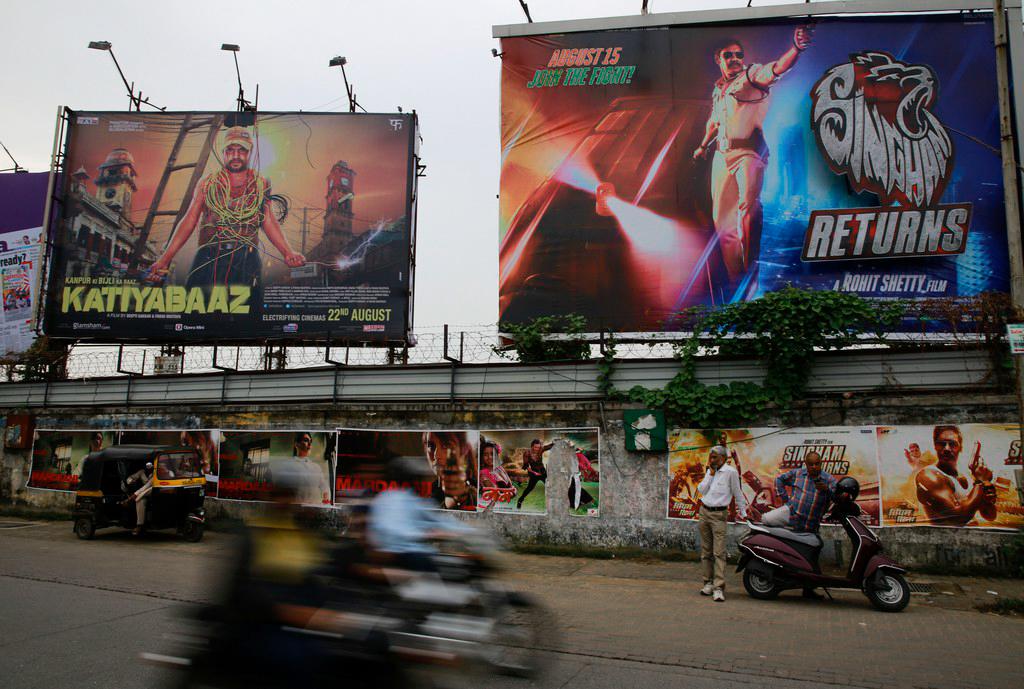Selling indie films to an Indian audience

Indian independent cinema has a whole section devoted to it at the tenth Zurich Film Festival. Despite doing well at international festivals, indie films struggle to attract an audience back home.
Two wannabe screenwriters Dulal and Mainak dream of making it big in Bollywood, India’s Hindi film industry based in Mumbai. They desperately try to pitch their concept to film producers without much success. Eventually they stumble upon the son of a film tycoon who commissions them to write a screenplay but there are strings attached.
This is the premise for the film, Writers (‘Sulemani Keeda’ in Hindi), directed by Amit V Masurkar, who was at the Zurich Film Festival for the film’s German-language region premiere. The film’s premise is a familiar real-life story for today’s talented Indian indie filmmakers.
Collecting enough funds to make even a low budget film is the first hurdle they need to overcome.
“Even though we managed on an extremely low budget without any star actors, towards the end of the filmmaking process we did not have any money to finish the film. It cost us more to do post-production than to make the entire film,” Masurkar tells swissinfo.ch.
Indie filmmakers often push the boundaries when it comes to the subjects that they address and this makes their films a controversial project to be associated with.
Even support from the Indian government often comes with strings attached. “The government supports harmless documentary films that do not question the system,” says national award-winning documentary filmmaker Nishtha Jain, who is also on the festival’s jury for international documentary films.
But even once the film is made, it is an uphill struggle to sell the film to an Indian audience.
Bollywood obsession
Among the audience filing out after the premiere is Lalitha Sukandkar, from a small town west of Zurich. “I would say that Indian independent films are more popular outside India. In the seventies these films were popular in India but not anymore,” she tells swissinfo.ch. She blames the dominance of Bollywood and other mainstream regional language films on the Indian audience’s need for escapism. “There is a lot of struggle in day-to-day life in India and people want to escape from that when they watch films,” she says.
Another cinema-goer, Mira Nagrath from north Zurich, comments that while she likes indie films, her relatives in India watch only Bollywood films.
But filmmaker Masurkar refuses to make Bollywood the scapegoat for the poor showing of Indian indie films. “It is wrong to say that the Indian audience doesn’t like indie films. They generally want to be entertained. It is up to the filmmakers to make the films that they will watch,” he says.
It is a view that is also shared by his producer Sailesh Dave. “You can never predict if the audiences will come. You could make a really big movie with a huge star and spend lots of money promoting it and still the audience might not come,” he told swissinfo.ch.
Prevailing audience tastes are a bigger problem for documentary filmmakers who tackle serious subjects and whose films often lack the entertainment value that is critical to the success of a film.
“There is a resistance from the audience to watch documentary films. In the past, Indian documentaries were dull and badly made and thus Indians have developed this mindset that documentaries are going to be boring,” says Jain.
Star power also has a big role to play in the success of mainstream Indian films and the lacklustre reception to independent films.
“It is the same all over the world, if you have a star you get more eyeballs. But in India there are lots of people who will watch an Amir Khan [Bollywood star] film just because it has him in it,” says Masurkar.
That doesn’t mean indie films don’t have stars of their own.
“Low budget, independent movies have created their own star system. If your film has high-brow actors like Irfan Khan or Nawazuddin Siddiqui then your core audience will automatically assume that it will be better than other independent fare out there,” says producer Sailesh.
But there is no doubt that a Bollywood blockbuster can destroy the prospects of an indie film at the box office. “Even if an indie film is doing well, a big studio film release could wipe out all the other films that are showing in the cinema theatre that week,” admits Masurkar. “The only way to beat Bollywood is to make a good film and hope that the first audience like it and spread the news by word of mouth.”
Established monopolies
In India, it is the film distributors who decide how big an audience a film can reach. Once a film is made it is up to distributors to pick it up and ensure it is shown in as many theatres as possible.
The problem lies with the distributors’ reluctance to back indie films.
“I’ve spent three years showing this film (Gulabi Gang) around to distributors. The distribution system has no interest in promoting films that highlight social issues,” says Jain.
Many distributors feel that indie films cannot attract a big enough audience to fill theatre seats even with limited screenings. This is despite the commercial success of recent indie films like The Lunchbox or B.A Pass that earned three times what they cost to make. As a result many indie films do not see the light of day, as distributors refuse to back them.
“Distributors have become gatekeepers of the Indian film industry by deciding what people should be watching,” says Sailesh.
And an audience that doesn’t get to watch indie films is unlikely to develop an appetite for them either. Even the fortunate indie films that do get screened struggle to make money after deducting the cut to theatres and distributors, as well as publicity costs.
Many indie filmmakers are hoping to bypass this system by distributing their films through new avenues like direct-to-DVD or video-on-demand services like Netflix. However, even these new platforms are beholden to traditional theatrical distribution.
“I don’t think direct-to-DVD or video-on-demand is going to help bypass the system because it is a decent theatrical release that provides the buzz and hype which gets you revenue from every other stream,” says Sailesh
Masurkar also thinks that new distribution platforms alone are not enough to break the distribution stranglehold. “If people have to pay money to watch a film online they need to know about the film. The film has to be recommended by their peer group or they need to have read the reviews,” he adds.
“A whole ecosystem needs to grow around independent filmmakers and only then can we grow in India,” concludes Jain.

In compliance with the JTI standards
More: SWI swissinfo.ch certified by the Journalism Trust Initiative

You can find an overview of ongoing debates with our journalists here. Please join us!
If you want to start a conversation about a topic raised in this article or want to report factual errors, email us at english@swissinfo.ch.